FC Universitatea Cluj
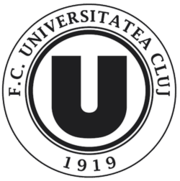 | ||||
| Full name | Fotbal Club Universitatea Cluj | |||
|---|---|---|---|---|
| Nickname(s) |
Şepcile roşii (Red Caps) Studenţii (The Students) | |||
| Short name | U Cluj | |||
| Founded | September 1919 | |||
| Ground | Cluj Arena | |||
| Capacity | 30,201[1] | |||
| Owner | Florian Walter | |||
| Chairman | Vlad Munteanu | |||
| Manager | Mihai Teja | |||
| League | Liga I | |||
| 2012–13 | Liga I, 12th | |||
| Website | Club home page | |||
| ||||
|
| ||||
Fotbal Club Universitatea Cluj (Romanian pronunciation: [universiˈtate̯a kluʒ], commonly referred to as U Cluj) is a Romanian professional football club from Cluj-Napoca, founded in 1919 by Iuliu Hațieganu. The team plays in Romania's top-flight league, Liga I. Universitatea Cluj traditionally plays in white and black clothing, although variations of red, maroon and gold have been used—especially for away kits. U Cluj played for 89 years at the Ion Moina Stadium, and then moved into the new venue Cluj Arena, built on the site of the old stadium.
U Cluj are nicknamed Şepcile roşii (English: Red Caps) after the red berets worn by students from the University of Medicine in Cluj. They are traditionally considered to be the most important football club in Transylvania, although their status has recently been threatened by the success of their city rivals CFR Cluj.
The club has spent most of its history in the first league but have never become national champions. They have played in four Romanian Cup finals—each time under a different name—and won the trophy in the 1964-65 season.
History
The Universitatea sports club of Cluj was founded in September 1919 by the "Sports Society of University Students" (Romanian: Societatea Sportivă a Studenţilor Universitari—abbreviated to "U"). Its first chairman was Professor Iuliu Haţieganu, a physician and politician. In the early years of its existence "U" Cluj played in local competitions; at the time there was no national football championship in Romania. The team played against Chinezul Timişoara in the 1923 final of the Mara Cup, losing 0-2. "U" played in the Romanian national football championship Divizia A from 1932. In their first season "U" finished first in its group and played the championship final against Ripensia Timişoara (0-0 and 3-5).
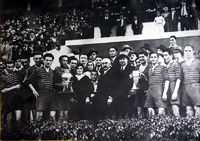
In the first season of the Romanian Cup, in 1933-34, "U" reached the final, losing against Ripensia Timişoara (0-5). In 1940, "U" moved from Cluj to Sibiu as a result of the Second Vienna Award, when the northern part of Transylvania was ceded to Hungary. In 1942, "U" played in the final of the Romanian Cup for a second time and lost against Rapid Bucureşti (1-7). In 1945, after the end of the Second World War and the return of the northern part of Transylvania to Romania, "U" returned to its home in Cluj.
In 1946, the name of the club was changed to Ştiinţa Cluj (English: Science Cluj). In 1949, the team reached the final of the Romanian Cup for the third time, but it was beaten by CSCA Bucureşti—now called Steaua Bucureşti (1-2).
At the end of the 1950s and the beginning of the 1960s, the manager of Ştiinţa Cluj was Ştefan (Pisti) Covaci—a famous Romanian coach who later became the manager of Ajax Amsterdam. In 1964-65, Ştiinţa Cluj won the Romanian Cup; this remained the greatest performance of the club for many years.
In 1966, the name of the team was changed back to "U". At the end of the 1971–1972 season, "U" was in the best position in the Romanian Championship Divizia A after the Second World War; it finished third in the league table, with the same number of points as the second placed team UTA Arad. In 1998, "U" reached the final of Cupa Ligii but lost to FCM Bacău. In 1999, "U" was relegated into the second Romanian division, Divizia B and in 2000 it was relegated for the first time in its history into the third division, Divizia C. It played one season in the third division, and in 2001 it was promoted back to Divizia B. The manager of the team at the time was the ex-Romanian international, Ioan Ovidiu Sabău—who started playing football in the 1980s at "U" Cluj.
In the 2005–06 Divizia B season, the new objective became promotion to the first league. Unfortunately, under coach Leo Grozavu, who often played highly defensive football, the team made many nil draws and the team lost second place (promotion play-off) by a point, though in the last match days they won 4-0 with the first place and the third, and 3-2 (after leading 3-0) with the 2nd place.
In the beginning of the 2006–07 Liga II season (Divizia B was renamed to Liga II in this season), a new manager, Adrian Falub—who had never coached before but had played over 220 matches for "U" Cluj in the first league—was engaged. Under his lead, the team had a poor early season and only reached 8th position. Yet, the moment passed and the team reached 1st position, often separated by over 6 points from the next position. In 19 May 2007, virtual promotion was achieved after a 0-0 draw against second place contender Dacia Mioveni. Three weeks before the final match day, "U" ended its 8-year spell in the lower divisions, returning to the first league for the 52nd season in its history.
Stadium
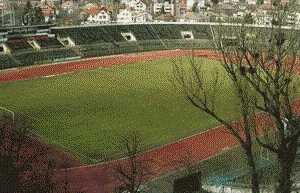
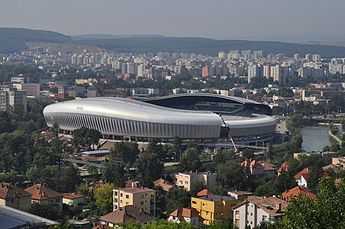
Ion Moina Stadium, the first football and athletics stadium in Cluj-Napoca, was built between 1908 and 1911 and had a capacity of 1,500. The official inauguration in 1911 was a game between a Cluj team and Galatasaray Istanbul. It was the first game in Europe for Galatasaray; the Cluj team won 8-1. In 1961, new U-shaped stands were built and the capacity of the stadium became 28,000. In 2000, most of the stands were declared structurally unsafe for hosting supporters and were closed, leaving the stadium with a capacity of 12-13,000. In late 2008, the old Ion Moina Stadium was demolished, and building works begun for the Cluj Arena. The last official game at the old stadium was played on 22 November 2008; Universitatea drew 0-0 in their Liga II game with Mureşul Deva.
During the construction works for the new stadium, Universitatea played the home games in the 2008–09 and 2009–10 Liga II seasons at the Clujana Stadium and the home games in the 2010–11 Liga I season at the Cetate Stadium in Alba Iulia, Gloria Stadium in Bistrița and Gaz Metan Stadium in Mediaș.
On 11 October 2011, the first match at the new Cluj Arena stadium—a friendly between Universitatea and the Russian team Kuban Krasnodar—was played; Kuban won 4-0. On 16 October 2011, the first official match at the new stadium was played; Univesitatea won the Liga I game against FC Braşov 1-0.
Rivalries
Universitatea have a rivalry with their local city opponents CFR Cluj. The animosity between the teams is one of the oldest in Romanian football. The first incidents between fans of the two sides occurred in the 1920s. A particularly violent episode took place during a derby played in 1924, when the stadium had to be evacuated because of a large-scale fight between supporters. Universitatea won the match 2-1. Other episodes of this rivalry are: in 2005, upset that Universitatea was relegated in Divizia C, "U" fans injured CFR's players at Sport Hotel of Cluj-Napoca; in 2007, a CFR supporter was killed by 15 Universitatea's ultras; in 2008, following a derby, CFR won and obtained its first league title and Universitatea relegated in Liga II, but this match was preceded by a corruption scandal, because Steaua Bucureşti's owner, Gigi Becali offered to "U" staff 1 milion euro for defeating CFR.[2]
Honours
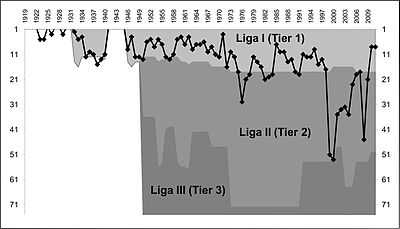
- Winners (0):
- Runners-up (1): 1932–33
- Winners (1): 2000–01
Romanian Cup:
- Winners (1): 1964–65
- Runners-up (3): 1933–34, 1941–42, 1948–49
- Winners (0):
- Runners-up (1): 1998
The “U” Cluj Under 21 and Junior teams have always ranked among the best in the country and have won several National Championship titles:
- The Under-21s were Romanian champions 3 times in: 1962–63, 1970–71, 1971–72
- The Under-21s were Romanian champions 8 times in: 1955, 1956, 1964–65, 1966–67, 1968–69, 1971–72, 1973–74, 2000–01
European record
| Competition | S | P | W | D | L | GF | GA | GD |
|---|---|---|---|---|---|---|---|---|
| UEFA Cup Winners' Cup / European Cup Winners' Cup | 1 | 4 | 2 | 0 | 2 | 3 | 6 | – 3 |
| UEFA Europa League / UEFA Cup | 1 | 2 | 1 | 0 | 1 | 5 | 6 | – 1 |
| UEFA Intertoto Cup | 1 | 4 | 0 | 1 | 3 | 3 | 8 | – 5 |
| Total | 3 | 10 | 3 | 1 | 6 | 11 | 20 | – 9 |
Current squad
As of 15 January 2014
Note: Flags indicate national team as has been defined under FIFA eligibility rules. Players may hold more than one non-FIFA nationality.
|
|
Technical staff
Current staff
| Name | Nationality | Role |
|---|---|---|
| Mihai Teja | Manager | |
| Emil Szolomajer | Goalkeeping coach | |
| Ioan Felecan | Physiotherapist | |
| Eugen Jascău | Physiotherapist | |
| Petruţa Coman | Psychologist | |
| Lucian Gherguş | Physician | |
| Daniel Sima | Junior Academy Manager | |
| Mihai Georgescu | Junior Academy Manager | |
| Orlando Borz | Junior Academy Coordonator | |
| Nicolae Szaboszlay | Technical Adviser |
Former managers
|
|
|
Shirt sponsors and manufacturers
| Period | Kit manufacturer | Shirt partner |
|---|---|---|
| 2009–12 | |
|
| 2013– | Safety Broker | |
Great players in team history
|
|
|
|
Supporters
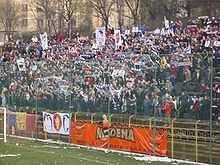
“U” has many supporters in Cluj-Napoca, but also in some other parts of Romania—especially in Transylvania. One of the reasons for the team’s popularity is that Cluj-Napoca has some of Romania's most important universities—including the Babes-Bolyai University, the largest in the country with more than 45,000 students.[3]
The ultras groups of "U" Cluj are: VG (Vechia Guardia), Fazione Accademica, UCG (Ultra Curva Groapa), Ultras 19, Fanatics, Boys, Battaglione Gheorgheni, F.O.R.T. and others.[citation needed]
Old crests
-

Old crest
-
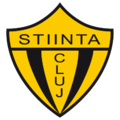
Old crest
-

Old crest
-

Old crest
References
- ↑ http://www.universitateacluj.ro/Stadion.html
- ↑ "TOP 10 rivalităţi din fotbalul românesc". ProSport.
- ↑ "First 10 romanian universities". Gândul. 2007-06-25. Retrieved 2009-03-27.
External links
| Wikimedia Commons has media related to CFM Universitatea Cluj. |
- Universitatea Cluj official website
- FC Universitatea Cluj on Facebook
- Universitatea Cluj supporters web page
- Şepcile roşii (Red caps)
- Cronica Bestiala
- r3Lu's photos
| |||||||||||||||||